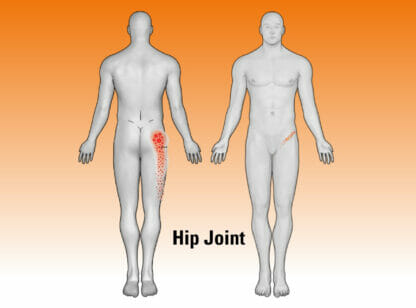You’re in pain and call your doctor’s office. They recommend you go to the nearest emergency room and hours later you receive a shot which controls the pain for some time. What if you could learn techniques to control your pain instantaneously without medication and the associated side effects? Hypnotherapy techniques can do just that: control your pain by controlling your mind.6, 8, 10
Pain is standardly categorized as either acute or chronic.8, 9, 10 Acute pain is usually defined as pain that lasts less than three months.10 It is a result of some sort of accident, medical procedure or natural process. After a period of healing, the pain will typically resolve itself. It is important to point out that pain is necessary for our survival. Without experiencing pain, we would not identify when we have suffered trauma. People who are unable to experience acute pain repeatedly end up with burns, injuries and broken bones.10
Chronic pain is usually defined as pain that persists for three months or more, following initial onset.9 With time, chronic pain can compound requiring progressively increased pain medication and physical assistance. It can also lead to depression, sleep problems and long and short-term disability.4, 8, 9
Unfortunately, as many as 37% of individuals in developed countries and 41% of individuals in developing countries report having had chronic pain in the previous 12 months, according to research scientist Mark P. Jensen, PhD, University of Washington vice chair for research in rehabilitation medicine.9 If not controlled, chronic pain can perpetuate creating a cycle of more pain, disability and impairment.7,9
How do we turn this around?
Many in medicine believe that pain is more than simply a physical ailment, but rather a complex interaction between biologic, cognitive, emotional, behavioral and social factors.7, 9 As such, Dr. Jensen adds, a key underlying principle in chronic pain treatment is patient empowerment.9
It is important to understand that the mind prefers homeostasis; it wants to keep the status quo and can be a powerful tool in chronic pain management, thus adding a psychologist and or clinical hypnotherapist to your pain management team can be beneficial.8, 9, 12 Whereas a physician can assess pain and identify physical treatments to aid in relieving pain, a psychologist can assist in identifying possible psychosocial causes and/or psych-related traumas that may trigger chronic pain.4, 7, 8 This is especially true when physical exams, x-rays, MRI or CT scans are unable to identify a cause, as this does not mean the pain is not real.1, 7, 12, 13
A clinical hypnotherapist uses techniques from various theories to help train clients how to use the mind to manage chronic pain.4, 5, 12, 13 Each technique uses custom-designed suggestions to meet the specific needs of each client. Two basic theories include the mind/body connection and pain gate theory.3, 6, 8 The mind/body connection recognizes that the subconscious controls the entire body: our heartbeat, blood pressure and all the systems necessary to keep us alive. It is believed that the mind controls our body’s responses to stressors and toxins, and by learning how to control the mind, we are able to control our bodies.2, 5, 11 By learning how to change our minds, we can change our bodies and the body’s responses.2, 5, 6
The pain gate theory basically states we are able to change our response to pain by “closing” the pain gate located in the neuro system.9, 12, 13 It recognizes that nerve fibers transmit signals up the spinal cord to the base of the brain. The thalamus, which sits are the base of the brain, then acts as a clearing house sending those signals to four areas of the brain. These areas then create the body’s response, attaching a specific quality to the signal. For instance, one area says the stimulus is a 10 out of 10 pain level. Another area says the stimulus is a burning or stabbing pain.9, 12, 13 Another area says the stimulus is located in a specific body part.9 Then finally, the fourth area attaches an emotional response such as anxiety, stress, etc.7, 9 The hypnotherapist is able to use various techniques to focus on changing the mind’s interpretation of the signal by addressing the different parts of the mind that construct the body’s response – changing the mind’s interpretation, and hence, the response.1, 8, 9, 12, 13
What is the hypnotherapy process?
The hypnotherapy process begins with a thorough evaluation designed to identify the unique needs of each client. The client and hypnotherapist then work as a team to build a custom treatment program focused on increasing comfort and functional independence. Sessions can be completed in office, via zoom or even in the comfort of your home. The number of sessions is based on individual needs and determined following the initial evaluation. After each session, the client receives an audio recording enabling them to use the recording in between sessions. The recording helps anchor the suggestions enabling control of the pain. At no time does the client lose control. Clinical hypnosis does not make someone do something that is against their will, ethics or moral code. Many people describe “waking” from hypnosis as feeling refreshed and revitalized.
Hypnotherapy assists clients in reformatting their understanding and perception of pain. In my practice, I have witnessed chronic pain clients regain control of their comfort and return to a productive society. Hypnotherapy has allowed them to resume caring for themselves and to participate in living life once again.
Dr. Richardson has worked in the rehabilitation sector of health care for more than 40 years. He is a certified hypnotherapist and proud member of Desert Doctors. He practices at Pit Stop Health Center in Rancho Mirage and can be reached at (760) 636.4365 or [email protected]. For more information visit www.kevinrichardsontherapy.com.
References: 1) Chips, D. A. (2004). Clinical Hypnotherapy A Transpersonal Approach – An Educational Guidebook (2nd edition). Goshen: Transpersonal Publishing; 2) Dispenza, D. J. (2017). Becoming Supernatural How Common People Are Doing the Uncommon. Carlsbad: Hay House, Inc.; 3) Edited by Mark P. Jensen, P. (2017). The Art and Practice of Hypnotic Induction – Favorite Methods of Master Clinicians. Kirkland: Denny Creek Press.; 4) Edited by Mark, P. J. (2018). Hypnotic Techniques For Chronic Pain Management – Favorite Methods of Master Clinicians, 2nd volume. Kirkland: Denny Creek Press.; 5) Edited by: Les Brann, J. O. (2012). The Handbook of Contemporary Clinical Hypnosis. Chichester: Wiley-Blackwell; 6) Elkins, E. b. (2017). Handbook Of Medical And Psychological Hypnosis – Foundations, Applications, and Professional Issues. New York: Springer Publishing Company.; 7) Gatchel, R. J. (2005). Clinical Essentials of Pain Management. Washington, D. C. : American Psychological Association.; 8) Joseph Barber, P. a. (1996). Hypnosis and Suggestion In The Treatment of Pain – A Clinical Guide. New York: W. W. Norton & Company.; 9) Mark P. Jensen, P. (2011). Hypnosis For Chronic Pain Management – Therapist Guide. New York: Oxford University Press.; 10) Mark P. Jensen, P. e. (2019). Hypnosis for Acute and Procedural Pain Management Favorite Methods of Master Clinicians – 3rd volume. Kirkland: Denny Creek.; 11) Milton H. Erickson – Edited by: Ernest L. Rossi, M. O. (1998). Healing Hypnosis The Seminars, Workshops and Lectures of Milton H. Erickson. London: Free Association Books.; 12) Patterson, D. R. (2013). Clinical Hypnosis For Pain Control. Washington, D.C.: American Psychological Association.; 13) William S. Kroger, M. (1977). Clinical and Experimental Hypnosis (Second Edition. Philadelphia: J.B. Lippincott Company.












































Comments (0)